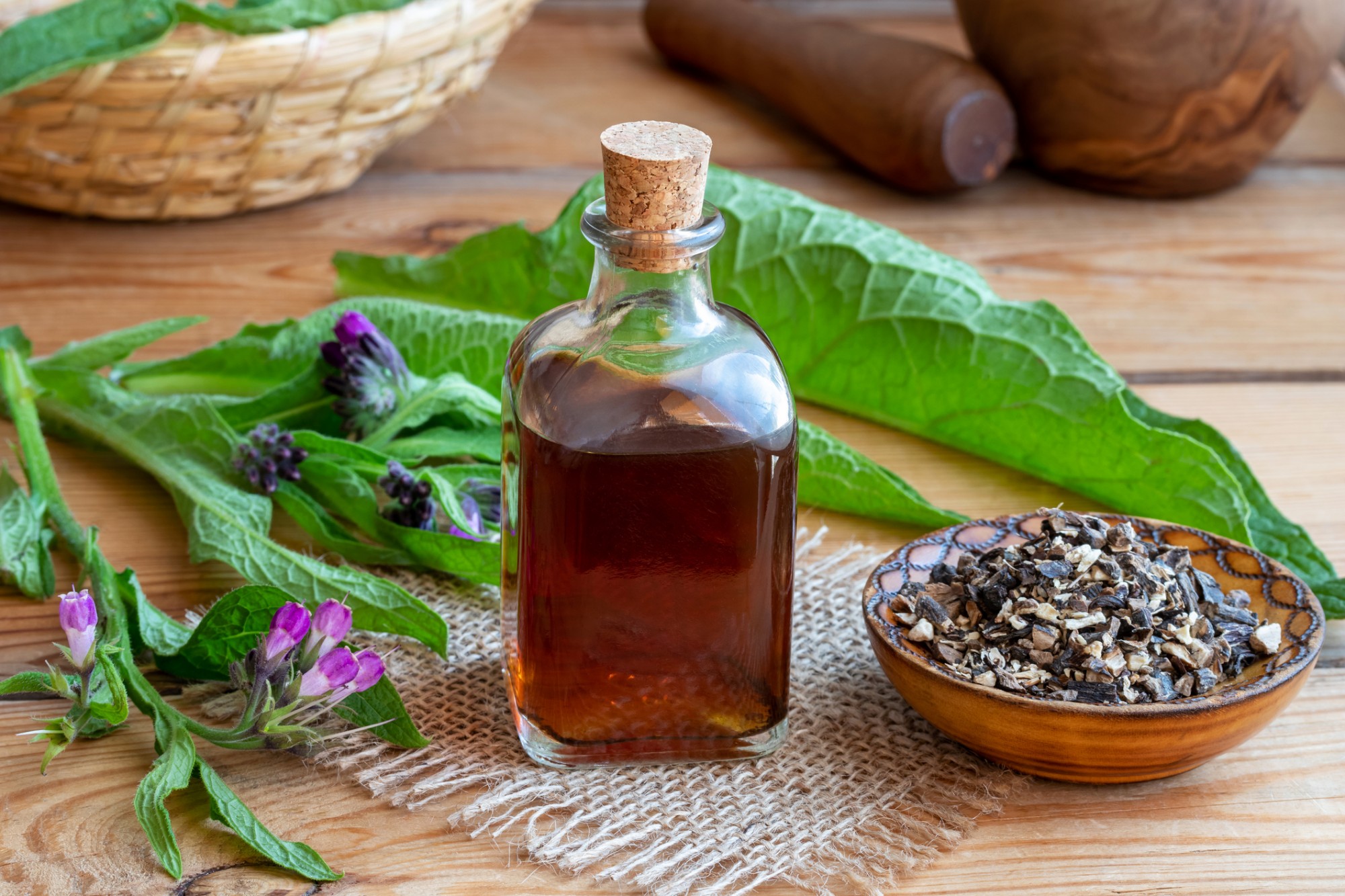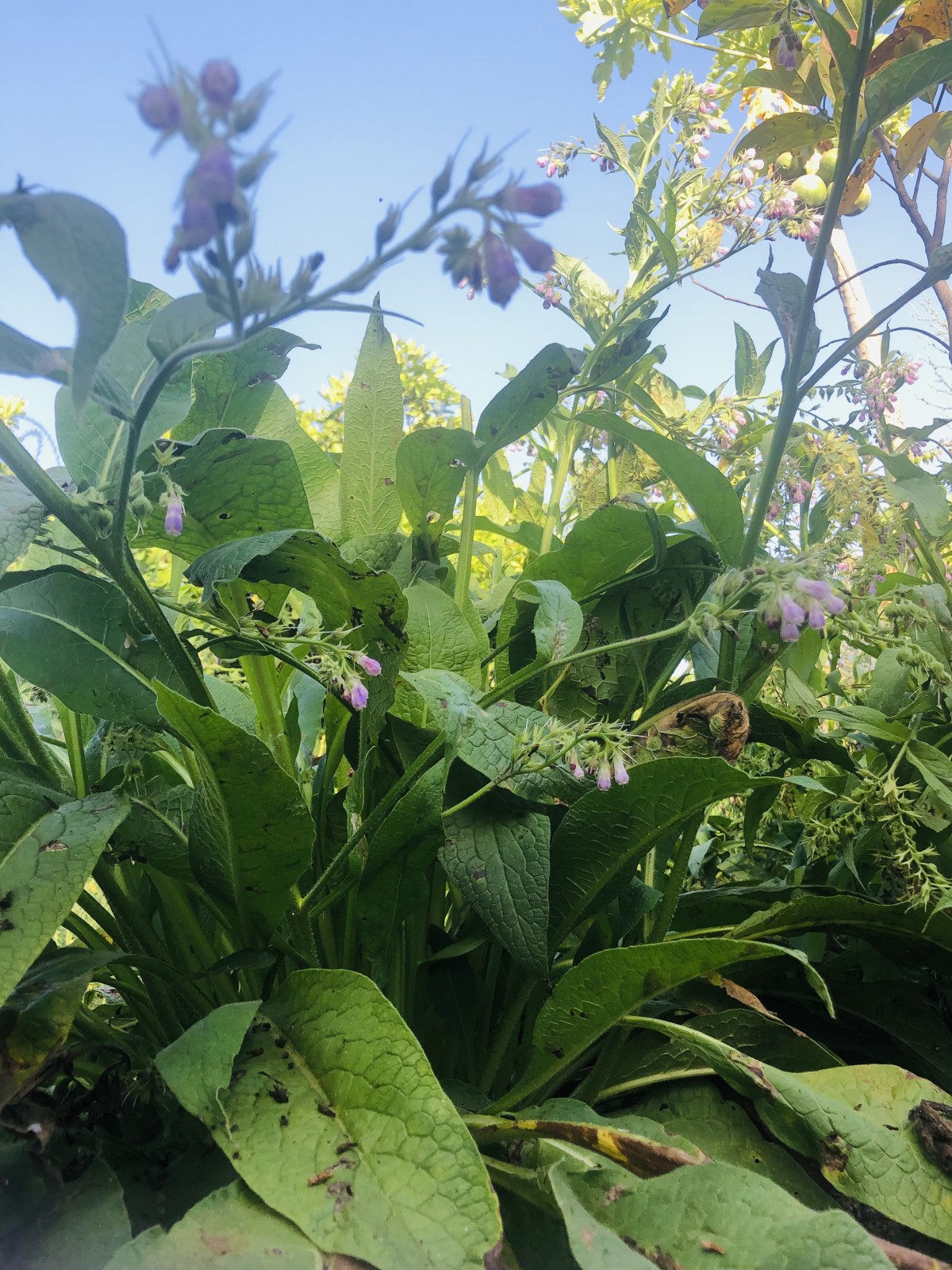Comfrey
From healing bones, treating skin issues, to home grown fertilizer
 Comfrey (Symphytum officinale) is a herbaceous perennial with large broad, hairy leaves and flowering stalks bearing white, pink, or purple bell-shaped flowers that reach 1 m in height. The botanical name for comfrey means “to unite” or “grow together”, and its common name, 'knitbone' is an indication of its most common use for healing wounds and fractures.
Comfrey (Symphytum officinale) is a herbaceous perennial with large broad, hairy leaves and flowering stalks bearing white, pink, or purple bell-shaped flowers that reach 1 m in height. The botanical name for comfrey means “to unite” or “grow together”, and its common name, 'knitbone' is an indication of its most common use for healing wounds and fractures.
Comfrey’s strong roots draw nutrients up from the soil which are stored in the roots and leaves, creating a powerful medicinal herb. The roots have a higher content of allantoin and rosmarinic acid, which give them an advantage over the leaves.
Rosmarinic acid helps relieve pain and inflammation while allantoin penetrates deep into the body’s tissues to speed up cell growth, which helps the body quickly replenish new collagen, connective tissue, and bone. Comfrey’s anti-inflammatory, demulcent, and astringent qualities also helps to reduce swelling, soothe, protect, and tone injured tissues.
In addition to being an ideal herb for healing broken bones and torn ligaments, comfrey’s astringent and anti-inflammatory qualities make it ideal for treating skin conditions such as dark spots, damaged skin, psoriasis, and eczema. .
Comfrey is such a potent wound healer that it should not be used on puncture wounds or deep cuts. This could cause the surface of the wound to heal over before the depth of the wound, potentially creating an abscess. Comfrey should not be used on a dirty wound for the same reason, as it will trap dirt and puss under the rapidly healing skin.
How to Use Comfrey
Traditionally comfrey leaves and roots have been used internally and externally, however, due to the presence of pyrrolizidine alkaloids, which can cause liver damage when ingested and used in high doses, it is usually recommended exclusively for external use.
Methods for external use include:
Poultice - Create a comfrey poultice using the leaf or root. Crush or blend together chopped leaves, stems, and roots with a bit of water to form a paste. Apply this thickly and liberally to the desired area. Wrap it with cloth or a bandage to hold it in place. Comfrey poultices should be left in place for several hours (overnight is ideal).

Oil - There are two popular ways to make comfrey oil, a slower and faster method. The slower method involves packing a glass jar with dried comfrey leaves and then pouring oil over them. Close a lid on the jar, place it in a paper bag to protect it from direct sun exposure, and place it on a warm windowsill. After two weeks, strain out the herbs and rebottle the oil.
For a faster method, place your dried comfrey and oil in a pan and heat them on low for 30 minutes to an hour or until the oil takes on the color of the herbs. Strain the herbs and bottle the oil. Apply the oil liberally to aches, pains, injuries, skin rashes or other areas in need of healing.
Comfrey oil can be stored at room temperature, but will last much longer when refrigerated.
Lotion - To make a lotion with comfrey oil, combine 1 cup of infused oil with 30 grams of beeswax, and add 1 cup of comfrey tea (pour 1 cup of boiling water over 2 teaspoons of comfrey and let cool)
Heat oil in a double boiler and stir until the beeswax is thoroughly blended. Remove from heat and add tea. Blend with a hand mixer until you get a texture you’re happy with. Unlike a salve, this lotion will stay fairly soft in the refrigerator.

Gardening With Comfrey
Comfrey’s deep roots work to bring nutrients up from the subsoil. The leaves are rich in nitrogen and potassium with a decent amount of phosphorus as well, making them a wonderful home grown fertilizer.
Comfrey grows best in soggy and marshy areas, but it adapts well to most environments, thanks to its deep, strong roots. Comfrey can be planted in full sun, though in hot and dry environments, it is best to provide partial shade and water regularly .
Comfrey is easy to propagate from seeds in spring or with root cuttings during autumn. The leaves and flowering parts are usually collected during the summer months, and the comfrey root is harvested during autumn. If you don’t want the plants to self-seed, remove flower stalks before they go to seed.
How and When to Harvest
Leaves can be harvested at any time they are present, although are best when large and mature. The larger, mature leaves also have lower concentrations of pyrrolizidine alkaloids,making them safer for use..
The roots can be harvested at any time. Over-harvesting is usually not a concern with comfrey. Digging up the root can actually help comfrey to spread by encouraging a new plant to grow from each root fragment left in the ground.
In our Bustan we have the variety - Symphytum officinale var patens which has pink-purple flowers.
Information in this article has been taken from the Chestnut School of Herbal Medicine
